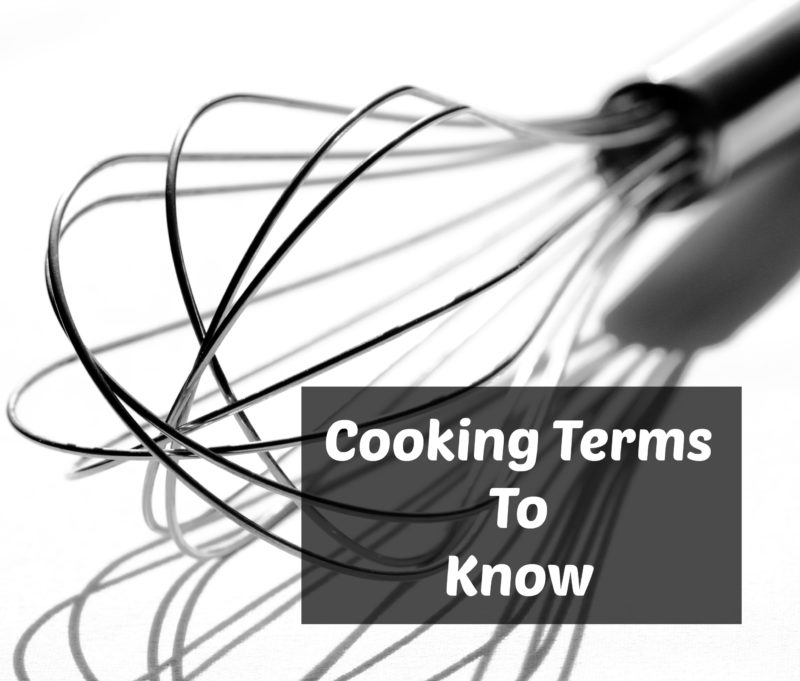
Before we dive into actual cooking I think it’s important for people who are new to the kitchen to learn some basic terms. This way we can all start on the same page and you always have this post as a resource to look back on as we move through this series. Understanding many of these terms will hopefully help you to feel more comfortable reading recipes, and trying new things. A number of the things on this list are the names of actual skills that every new cook should learn (like sauté). We will go over these skills in more detail later on.
Al dente: An Italian term meaning “To the tooth”. It requires the food to be cooked so that it has a slight resistance when biting into it, but should be hard in the center, conversely it should also not be completely soft in the center.
Bechamel: A rich white sauce infused with milk, herbs and butter.
Braise: To sauté meat or vegetables, and then slowly cooked with liquid over low heat.
Broth: A flavorful liquid like substance made as a result of boiling bones, vegetables, and herbs in water. Typically it uses less meat part and is lighter in color than stock (see below).
Charcuterie: A French term for the cooked meats ranging from bacon to cured meats and sausage (think salami and pepperoni).
Chiffonade: A French term for a particular knife cut where herbs and leafy greens are cut into thin strips and typically used to garnish a plate or soup.
Deglaze: The process of removing the browned bits from the bottom of a sauté pan with the use of liquid and heat.
Dredge: To lightly coat food with flour, cornmeal, or breadcrumbs.
Dust: To lightly coat food with a powdery ingredient or to lightly coat a work surface with flour.
Emulsion: To have one liquid suspended in another, often with liquids that do not mix easily, so emulsions are performed through vigorous stirring or shaking. For example, the combination of oil and vinegar to make salad dressing.
Fond: The roasted browned bits that form on the surface area of a baking sheet, typically used to make sauces.
Gratin: A dish that is topped with cheese or breadcrumbs and dabs of butter and then baked in the oven.
Grease: To apply a thin layer of butter or oil to a cooking surface to prevent food from sticking when cooked.
Infuse: To soak herbs, teas or fruits in liquid to extract their respective flavors.
Kosher salt: A flaky type of granular salt. It is typically proffered in cooking because of its lack of additives.
Leaven: The addition of ingredients (such as yeast, baking soda and baking powder) which cause dough to rise.
Mirepoix: A combination of chopped carrot, celery, and onion.
Mise En Plas: French phrase meaning “putting in place”. Typically referring to setting up cooking supplies, including tools, measured out ingredients and anything else necessary to cook the desired dish.
Mesclun: A combination of small leafy greens often found in specialty stores and food co-ops.
Macerate: To immerse food in liquid to breakdown and soften. The technique is commonly used to infuse fruit with liquor and vise versa.
Muddle: To press fruit and herbs against the side of a glass to release their juices.
Pinch: To grasp a small quantity of spices or seasonings between the thumb and forefinger for sprinkling over food.
Purée: To place vegetables or fruit in a blender or food processor and process until smooth.
Roux: A combination of fat (typically butter) and flour cooked over low heat used to thicken soups and sauces.
Rest: Allowing the prepared food to sit at room temperature, typically referring to meat, when resting allows the juices to reabsorb.
Reduce: To boil excess liquid in a cooking pan in order to decrease the volume through the process of evaporation. Doing so concentrates the flavor of the dish to be served.
Sauté: To cook food quickly in a skillet, using a small amount of oil or animal fat over medium high heat.
Simmer: To cook food over low heat, whereby small bubbles rise to the surface of a cooking pot. Simmering is the desired process for making stock.
Stock: A flavorful liquid/gelatin like substance made as a result of boiling bones, meat, vegetables, and herbs in water. It is typically darker and has a richer flavor than broth (see above).
Umami: The fifth flavor element not covered by sweet, sour, salty and bitter. Most often associated with Japanese cooking.
Whisk: To stir egg whites or heavy cream with light rapid movements, thereby forcing air into food.
Zest: The aromatic outermost part of a citrus peel used to flavor food to great effect.
Any terms that you think I missed or have other questions on? Please let me know and I will add to this list!
